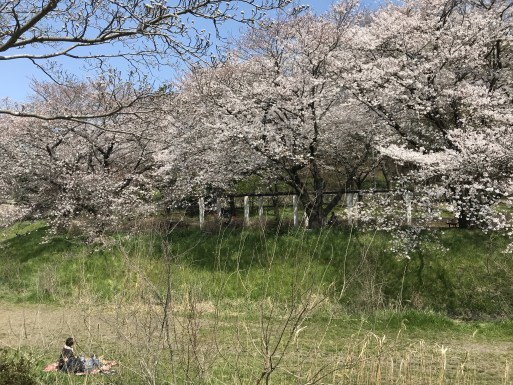Michael Pronko's Blog, page 6
June 2, 2020
San Francisco Book Review 4.5/5
Tokyo Traffic
Star Rating: 4.5 / 5
When violent intruders interrupt a film shoot in a Tokyo pornography studio, they brutally murder three people, but overlook a young actress hiding in the cavernous building.
Sukanya is an illegal Thai immigrant who was smuggled into Japan and lured into the business with the promise of big money and transit to the United States. She makes her escape with cash from the dead director’s wallet and a leather bag containing a computer and iPad. Penniless and friendless, she wanders aimlessly through the streets of the megalopolis; though she’s lost, she’s not undetected. Unknown to her, the digital devices she’s taken contain sensitive information as well as trackers that reveal her location.
Kenta, a shady businessman and loan shark wants those devices back. The information they hold could compromise him and his relationship with Yoshitaka Kirino, the ruthless mastermind of the criminal enterprise he’s involved in. Kenta assigns three street punks the task of recovering the priceless data as well as the only person who witnessed the crime.
Detective Hiroshi Shimizu was trained as an accountant in America. Now he’s a Tokyo detective specializing in deciphering the finances of criminal activities by examining bank records, statements, spreadsheets, and cryptocurrency. Money trails extend “like spokes from every murder,” and Shimizu has the expertise to grasp their implications.
As Sukanya tries to elude the men sent by Kenta, she’s assisted by Chiho, a young Japanese woman who empathizes with were predicament. Together they manage to stay one step ahead of their pursuers. But for how long? It’s a race to see if Hiroshi and his colleagues can unravel the motive and identify the murderer(s) before they catch up with Sukanya and the evidence in her possession.
While being a tightly plotted, well-structured murder mystery, Tokyo Traffic provides insights into criminal activity surrounding pornography, the sex trade, human trafficking, and to some extent how organized crime uses cryptocurrencies to transfer and conceal profits from illegal activities. Equally engaging is author Michael Pronko’s knowledge of contemporary Japanese culture including food, fashion, entertainment, and the environs of the world’s largest city. Pronko’s characters are fully developed, his dialogue is authentic, and his writing is clear and concise.
An ambitious novel, Tokyo Traffic at times feels bogged down with the excessive Tokyo travelogue, a confusion of characters, and plot minutiae; however, realistic detective work, action, romance, and even humor make for an overall entertaining and enlightening story.
Reviewed by Rod Raglin
Chanticleer Review of Tokyo Traffic
Chanticleer Review of Tokyo Traffic
Rating: 5/5; Highly recommended
Michael Pronko’s novel, Tokyo Traffic, the third book in the Detective Hiroshi Series, will pull you in from the first page and keep you turning to the final word. He develops a mystery/thriller that gives nothing away while leading us down dark back alleys in his exotic Japanese Tokyo Prefecture setting.
The title, Tokyo Traffic, catches our imagination, as though the book might explore densely populated Tokyo and the traffic that gets snarled on freeways and down narrow dori’s, or the pedestrian traffic that surges through Shinjuku and down crowded sidewalks almost shoulder to shoulder in a sea of humanity. And actually, he captures both of those meanings in his book, but he also explores the underlying theme of human trafficking, especially of underage girls.
Pronko develops a rich cast of characters and builds a dangerous and evolving world in which they play hide and seek. Sukanya, a fourteen-year-old Thai girl and overall kickboxing badass, is our first point of view character. She escapes a murder scene with clothes she scavenges, a wad of bills, a laptop, an iPad, and thus begins the wild ride, Tokyo Traffic.
Sukanya runs from Kenta, another badass, but one who finances the porn and human trafficking, while racing his Nissan GT-R down Tokyo’s highways and byways, avoiding the law and Kirino. Kirino would like to teach him a lesson, the hard way.
Our hero, Detective Hiroshi, finds himself in the middle of a Tokyo that most tourists never see. Hiroshi chases Kento and Kirino, a larger fish in the human trafficking pond. They race from the docks of Yokohama to hard porn studios in downtown Tokyo. Hiroshi follows the money, and Pronko gives us the world of crime using cryptocurrency and blockchain technology.
This is a convincing backdrop that doesn’t overpower us with corruption and porn but focuses on the characters and their struggle to survive. Pronko handles his plot and world-building deftly and creates a sympathetic vehicle to explore and bring light to the horrors of what it might be as a child caught up in the drug-addled world of human trafficking and child porn.
Tokyo Traffic is a fast-paced thriller that introduces us to a world we might have heard about on the news. Pronko develops characters that leap off the page. We want them to escape, we want them to get caught, we want them to solve the case, and Pronko keeps us guessing right to the end, as we wonder who will eventually win in this high stakes game of humans for sale.
This book will not disappoint, in fact, you won’t be able to put it down.
“In a dangerous and evolving world of human trafficking and porn, one man returns to make certain the Tokyo streets remain safe. Pronko delivers another breath-taking, action-packed thriller you won’t be able to put down! Highly recommended.”
Chanticleer Reviews
The Bookbag
The Bookbag
Reviewer: Sue Magee
There were three young women, girls really if you wanted to be pedantic about their ages. Sukanya was Thai and she’d come to Japan in the belief that she’d be able to pick up the documentation to get to the States. Celeste was just fourteen and when we meet her she’s already dead of a heart attack caused by an overdose of amphetamines. Then there’s Ratana, who’s the de facto leader of the group, but she’s disappeared too with the group’s passports, leaving Sukanya in the midst of a scene of carnage at the Jack and Jill Studios. The dead bodies are definitely not props though.
Sukanya knew that she needed to get out of the studios and it seemed wise to take some insurance with her. Money always came in useful and she collected an iPad and a laptop as she left, keeping as much undercover as she could. What she hadn’t appreciated was the tracking devices in the computers. Whilst she’s trying to find Ratana, Kenta Nakamura has been called in to clean up the mess at the studios by Shibaura who runs Jack and Jill. They’re both more than a little nervous about the appearance of Yoshitako Kirino – and Kirino would like to get hold of Sukanya, who’s not just hiding in Tokyo – she’s determined to get her passport to get to America.
Detective Hiroshi Shimizu has moved in with his girlfriend, Ayana, and the relationship seems to be going well. Those of us who have been with him from the start know that he has form so far as failed relationships go. Much as he loves the women – and he does love Ayana – he finds it impossible not to give his all to the job and if a woman loves you, the irregular hours and danger eventually drown the emotion. But Hiroshi is an accountant in the police force, so why does he get into danger? Well, he speaks English and that’s too useful for the force to pass up and that (and his accounting skills) is why he’s out of his office at a porn studio where there’s been a triple murder.
The story obviously takes place pre-COVID-19, but otherwise, it’s bang up-to-date with young girls being trafficked for sex and the tracing of money being made more difficult by the use of cryptocurrency. The characters are superb. Regular readers will know some of the policemen. There’s the head of homicide: making an appearance is his main job. The combination of Hiroshi, Sakaguchi and Takamatsu is excellent: they get the job done, but sometimes you’re not quite certain how.
The city of Tokyo is very much a character in its own right: I’ve never been but every time I read one of Michael Pronko’s Detective Hiroshi books I want to go there. It’s not the tourist hotspots we see, but the real city with the food and drink which the locals consume. It’s glorious.
The writing is skillful and evocative: They couldn’t speak the world’s two most common languages – English and numbers. The only thing he took away from examining a corpse was nausea.
Pronko does a good job of uniting two genres: Tokyo Traffic is part police procedural and part thriller. You know who the baddies are from early on: the question is how they’re going to be caught. It’s a great page-turner with real tension towards the end and I hope that it won’t be too long before we hear more about Hiroshi.
If the story appeals you might want to start the series at the beginning. I promise you that you won’t find it a hardship.
Blue Ink Review Starred Review
STARRED REVIEW
(Reviewed: June 2020)
Michael Pronko’s Tokyo Traffic, the third in his compelling crime series featuring Tokyo police detective Hiroshi Shimizu, revolves around human trafficking and the use of undocumented and underaged foreign women in Japanese porn movies.
The novel opens with a grisly scene: three people brutally murdered in a warehouse where porn films were made. Thai woman Sukanya survived and escapes with a wad of cash, a laptop, and an iPad. Wandering into the heart of Tokyo, she’s befriended by a Japanese woman, Chiho, who welcomes her into her tiny “apartment,” a booth at an Internet café where she sleeps under a desk.
Meanwhile, gangsters—including the trafficker; another man who is more entrepreneurial than evil; and three low-level thugs —are after the computer and iPad, which contain incriminating videos and business documents. When Chiho’s friend offers to hack into the computer, a tracker is unwittingly activated, giving away their location.
The detectives previously featured in the series return here: Hiroshi Shimizu, formerly an accountant, who’d rather work a safe, desk gig but finds his forensic financial skills are needed in the field; Sakaguchi, a former sumo wrestler; and Takamatsu, Shimizu’s mentor, a bossy know-it-all.
Journalist and critic Pronko has lived in Tokyo for decades, and his appreciation and knowledge of Japan and its people shines throughout. He skillfully captures the feel of Tokyo and cultural nuances, such as this poetic description of what a kendo (sword-fighting martial arts) competition sounds like: “The shout -whacks, squeak of feet, and short screams formed a collective rhythm, like the buzzing attack of large, angry insects with hard shells and deadly stingers. ” It’s clear the author knows Japan deep in his soul.
Pronko is also a masterful storyteller. As the narrative’s tension builds, readers will find themselves racing toward the inexorable moment when police, victims, and villains collide.
A riveting story, Tokyo Traffic is sure to leave readers yearning for the next Hiroshi Shimizu novel.
Best Thrillers (bestthrillers.com)
Best Thrillers (bestthrillers.com)
The Bottom Line: A first-rate hardboiled crime novel set at the nexus between porn, human trafficking, crypto-currency fraud and murder.
Michael Pronko’s third Detective Hiroshi series novel begins with a bang as Sukanya, a drugged Thai teenager, narrowly escapes a brutal mass murder at a well-known porn studio. In shock, she flees with a bag, an iPad and a computer containing damning evidence.
When Detective Hiroshi arrives to survey the crime scene, he discovers that one of the dead is a bureaucrat in the Ministry of Finance. He also finds a folder filled with passports for girls from five different Asian countries. What was the motive? Who would target foreign girls, a well-known film director, and a bureaucrat all at the same time?
Forensic accounting is Hiroshi’s superpower, and he wields it deftly to audit the porn studio’s systems – or at least what little evidence the sophisticated crime syndicate left behind. Meanwhile, a gangster named Kenta – the link between the studio, the girls, the government and the murders – turns on the tracking signal that he hopes will lead him to recover the incriminating items Sukanya stole from the studio.
While Pronko reveals the key players behind the crimes right from the start, riding along with Hiroshi as he meticulously hunts them down is intensively satisfying. Along with his forensic study, he employs a good deal of old fashioned shoe leather, and that’s where the novel’s texture really shines. Hiroshi’s Tokyo is an extremely evocative universe, and the places he visits in the course of the investigation – ranging from his favorite jazz-themed coffee shop to a basement nightclub or the cobblestoned Kagurazaka shopping district – are drawn with just enough sensory detail to induce the imagination without slowing the book’s perfect pacing.
With Tokyo Traffic, Pronko further establishes Hiroshi as one of the most distinctive and intrepid detectives in contemporary crime fiction.
Advicesbooks
Review Tokyo Traffic Michael Pronko
MAY 25, 2020
This could be defined a book about cryptocurrency, or rather, a fiction book on cryptocurrrency. While illegal digital currency exchanges are the leading thread of this mystery novel, the author unravels the dark side of Tokyo elite, with all of its perverse industries and the related depravity, where a crime is never a surprise, but an unexpected rule!
I am discussing about Tokyo Traffic, the Book3 of the acclaimed mystery series by Michael Pronko. And this is my review about this gripping and unconventional novel. Let’s start from a few clues about the plot.
The story is set in the multiethnic city of Tokyo, where aspiring entrepreneurs are more and more involved in borderline businesses that aim only to make money.
Yes, money, but what t a type of money? That is not the usual currency, but crypto currency, namely a digital currency exchanged only through online platforms that are impossible to be tracked. This digital currency is used for an awful human traffic where underage girls are kidnapped and brought to Tokyo by boat.
The girls are drugged to be turned into porn actresses under the lascivious gaze of the so called bystanders. These are wealthy and powerful persons who pay producers and movie directors to attend the shooting… The younger the girls are, the more they pay… But, one day, this profitable mechanism breaks and a brutal murder takes place… One of the victims is an underage girl!
It is in this stage that readers will be involved in the investigation of Japanese detective Hiroshi Shimizu. The detective is very attentive and never forgets details. He has been trained in the United States and speaks English. It has, hence, the flair of a Western policeman, such as a modern Hercule Poirot or Sherlock Holmes.
Truth to tell, this Japanese hero reminds me a popular Italian detective. I mean Inspector Montalbano. The latter moves in a dark scenery made of lies and depravity, where respectable persons are never such. In Tokyo Traffic, Hiroshi Shimizu is just the hero called to unmask the evil disguised as respectability.
The novel splits in alternate chapters, where readers will meet another gripping character: Thai girl Sukanya. She escaped her captors and holds a PC that can be pivotal to discover the shocking reason of the crimes occurred in the Tokyo porn studio.
I know well the writing style of the author of this new Japanese mystery. It is an American professor who lives and teaches in Tokyo. I already reviewed the book1 The Last Train and the book3 has the same unmistakable style. It is perfectly written in English and pushes readers to think about the dark sides of global economy and modern world.
Here, Tokyo is described in all of its beauty and ugliness, where the sparkling world of music clubs, internet cafes and teen hangouts are tainted by a dismaying traffic of young people.
In the story, teen girls are like consumer goods, where they count less than money, because the latter is more important and often funded by politicians, with the complicity of the law makers! Tokyo Traffic explores human trafficking, cryptocurrency and porn crimes without ever fall into morbid descriptions.
Indeed, the novel is not an erotic mystery. It is a literary work with a well arranged background, where the borders between good and evil are perfectly outlined and never granted!
It is a must read book, one of a few excellent novels against the international traffic of teenagers. The work is, in short, a strong call to save many innocent girls from the awful grip of sexual trafficking.
https://www.advicesbooks.com/review-tokyo-traffic-michael-pronko/
And in Italian!
https://www.advicesbooks.com/recensione-tokyo-traffic-michael-pronko/
May 23, 2020
May 21, 2020
Early reviews of Tokyo Traffic
“A dark and striking thriller with an indelible cast and setting,” Kirkus Reviews.
“Starts fast and doesn’t let up on its breakneck pace until bodies (both living and dead) are strewn all over the place,” Pacific Book Review.
“With Tokyo Traffic, Pronko further establishes Hiroshi as one of the most distinctive and intrepid detectives in contemporary crime fiction,” Best Thrillers.
“This is a classic thriller in terms of the gritty atmosphere, the dark characters and the brave and slightly broken hero,” The Wishing Shelf.
“Pronko delivers another breath-taking, action-packed thriller you won’t be able to put down! Highly recommended,” Chanticleer Reviews.
March 28, 2020
Strange Hanami
With the coronavirus throwing an invisible wrench into Tokyo’s routines, this year’s hanami season might be the most curtailed, and the strangest, ever. The mayor of Tokyo asked everyone to restrain themselves from parties under the blossoms, but restraint and hanami is a new combination.
Once upon a time, in the golden age of hanami, giant companies, alumni associations, and groups and circles of all kinds staked out huge tarps in prime spots for when the workday ended (early) and people packed in tight circles, drinking, singing, and letting loose. But this year, things have changed.
Of course, everybody still wants something from the cherry blossoms—bonding, nostalgia, poetic reverie, or Instagram moment, but they seem to have toned down their demands. Or been forced to. The hanami this year are set to shrink to smaller social units—families, couples, a few mothers with kids. There are more people walking than sitting, more daydreaming than drunk-shouting.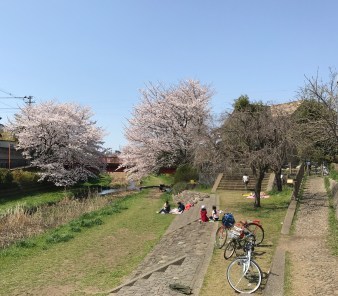
Cherry trees, it seems to me, are the hardest working trees around. Timeworn, dignified and quietly luminescent, they preside over whatever happens below, be it loud or quiet, rowdy or tranquil. Unlike most trees, which shoot up and away from the earth, cherry trees lean down like a grandmother calming a crying child. This year, though, there won’t be many children to embrace.
Every year, I go to at least one park famous for cherry blossoms. It’s crowded but stunning. But now that the coronavirus is dividing our lives into essential and non-essential, I’ll stay close to home. I’m lucky that my nearby park has rows of cherry trees, but that’s the same for most people. I can even see a few cherry trees from my back porch, not unusual in Tokyo, but an honor just the same.
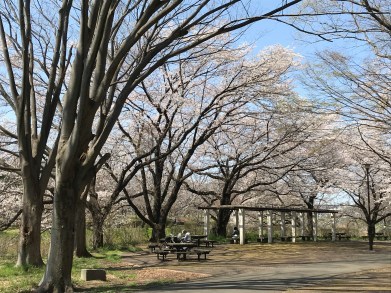 About half the blossoms were out during my usual jog through the park the other day. Near where I turn back home, there’s an old man I often stop and talk to. His house is right next to the walkway that meanders through the park. He is small, wiry and sunbaked. He told me one day he had been featured on a TV show about “super grandfathers.” He jogs a couple hours every day, down to a local temple, and keeps a jump rope on a rail outside his place. He smokes.
About half the blossoms were out during my usual jog through the park the other day. Near where I turn back home, there’s an old man I often stop and talk to. His house is right next to the walkway that meanders through the park. He is small, wiry and sunbaked. He told me one day he had been featured on a TV show about “super grandfathers.” He jogs a couple hours every day, down to a local temple, and keeps a jump rope on a rail outside his place. He smokes.
But more amazing than his physical health is his collection of bonsai. That’s why I spoke to him in the first place, to compliment him on how wonderful they were. I eye them in passing where he leaves them on small shelves of plywood balanced on beer cartons. They spill onto the sidewalk and down a slope to the river to catch sun and rain.
When I stopped to chat, he was focused on the roots of a bonsai that, he told me, was a hundred years old. He said it was given to him by a man living two doors down. Where is he now? I asked. He passed away, he said, and his son moved into an apartment close to the station. The former ‘owner’ had it for sixty years, and he had kept it for the forty years since.
And then he went on to recite the ages of all the rest of his bonsai, dozens and dozens of them scattered across the sidewalk and along the rigged-up shelves outside his home. That one’s twenty years, that’s ten years, that’s twenty-six years old. Even the full-size sakura along the river, he told me, had only been planted when they put in concrete banks forty years ago.
He then told me when they blossomed or bore fruit, which ones were related by cuttings from the parent, and from whom he’d received them, or whether he had sprouted them himself. In short, like a storyteller in some ancient village, he recounted the histories and relations and characteristics of them all.
Because it’s the middle of hanami season, I asked if one with a wide, white blossom was a sakura. He told me it was only twenty years old and explained how hard sakura were to work with. You must start on them before the bark hardens or they won’t turn out interesting. He was disappointed in the one he had, because he had let it get too tall too fast.
It has nice blossoms, I pointed out. He frowned. I looked at the shidare sakura whose branches hung like lit-up willow trees over the curve of the river, and two full somei yoshino cherry trees that eclipsed a bridge.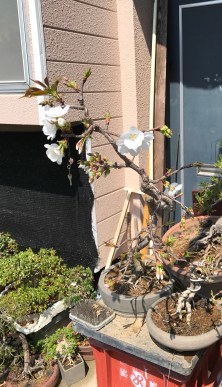
He pointed out another bonsai, down on the back shelf, out of the sunlight. Check out those blossoms, he said. I bent all the way over to look, but I couldn’t see them. He reached down and pushed one up with his rough fingers, and wiggled it back and forth. There were a dozen near-blossoms along the thin branches.
That one will take a long time, he said, waving his round-handled cutting scissors at me. I wondered how long he planned to work on it. He had told me one day he was ninety years old. That’s why he was on TV. Of course, he was working on a one-hundred-year-old tree, the only thing older than him in his collection.
I looked again at the bonsai sakura, elbow-high in its shallow, circular pot, a contrast, or maybe complement, to the riverside trees. I realized he didn’t really think of the bonsai as his own. He was the caretaker for a few decades, before a new caretaker took over.
When I stood back up, it wasn’t his age or vitality, or even his skill with the bonsai that struck me the most. It was more his quick shifts of frame that startled me. He seemed to move so easily between panoramic vista and pinpoint attention, from a hundred years to a tiny blossom.
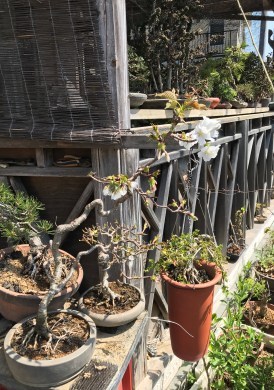 I couldn’t quite think in those terms, nor in the small frame, either. Maybe I’d always been stuck with middling sizes and narrow timeframes. He seemed to encompass the boundaries.
I couldn’t quite think in those terms, nor in the small frame, either. Maybe I’d always been stuck with middling sizes and narrow timeframes. He seemed to encompass the boundaries.
I bowed and apologized to him for interrupting his morning’s work. He smiled and told me to stop by anytime. And I turned back toward home along the river bank.
After I got back into rhythm, I felt that was enough for me—one tiny, curved cherry tree, with just a few blossoms and roots no bigger than my clawed hand. I liked the huge cherry trains arrayed along the river, certainly, and those spreading their branches here and there in the park—even more once I could see them more clearly. But they meant something different than a decades-old bonsai with its power to open my mind and focus it on things that last longer, and are much larger, and much smaller, than my own life.
March 29, 2020